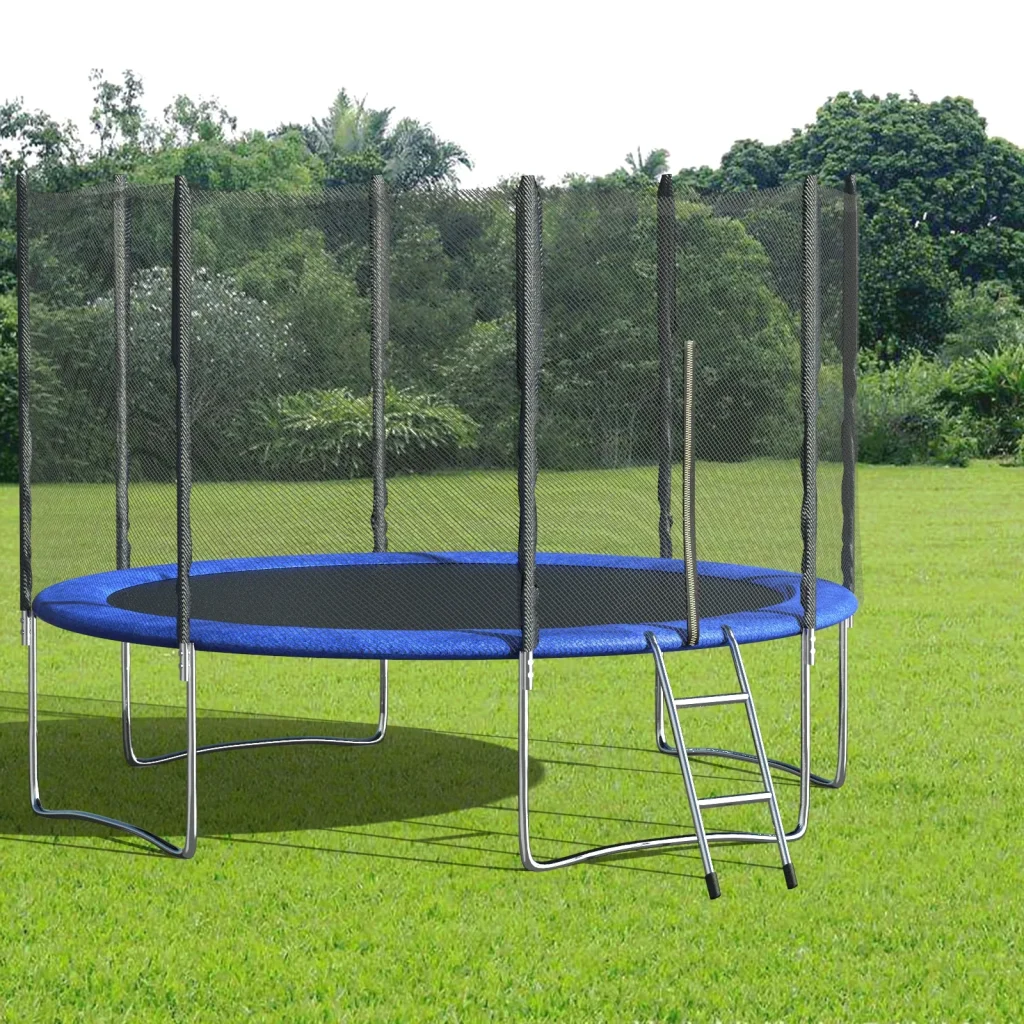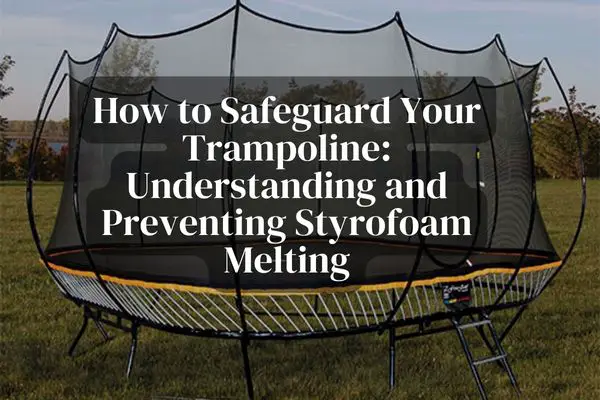If you’ve noticed the Styrofoam on your trampoline starting to melt, you’re not alone in your concern. This puzzling phenomenon can be attributed to a combination of factors, primarily environmental conditions and material properties.
Styrofoam, a common material used for padding on trampolines, is sensitive to heat and can begin to soften and deform under certain conditions. Factors such as prolonged exposure to sunlight, high temperatures, and even chemical reactions can contribute to this melting effect.
Understanding why the Styrofoam on your trampoline is melting is crucial not only for preserving the integrity of your equipment but also for ensuring safety during use. In t
his exploration, we’ll delve into the various reasons behind this occurrence and discuss potential solutions to mitigate its impact.
What Causes Styrofoam to Melt on Trampolines?
There can be a few reasons that your trampoline Styrofoam melts. Let’s discuss a few common facts:
Sunlight and Heat Exposure
Styrofoam is vulnerable to heat, which causes the closed-cell foam structure to soften and collapse. Ultraviolet rays from sunlight can degrade polymers in the material over time. Using the trampoline on hot days also transfers thermal energy that melts Styrofoam.
Friction from Jumping
The repetitive impacts and rubbing of gymnasts’ feet introduces friction and kinetic energy into the system. This dynamic movement and pressure melts the foam, especially in high traffic areas like the center. The more frequently the trampoline is used, the faster heat builds up.
Chemical Reactions
Chemicals used on the trampoline frame, mat, and springs may interact with Styrofoam. Some metal alloys, cleaning agents, or vinyl materials can emit reactive compounds when heated, bending polymers. Environmental pollutants could also play a role.

Effects of Styrofoam Melting on Trampoline Safety
If trampoline Styrofoam melts it can create some safety concerns.
Compromised Structural Integrity
Melted foam loses its supportive strength and shock absorption. Thinner padding reduces protection upon impact. Weak sections may tear or create gaps, allowing unsafe protrusions. This escalates injury risks significantly.
Increased Risk of Injury
Open cells, diminished thickness, and uneven coverage remove safeguards for gymnasts. More force transfers through degraded foam during falls, increasing potential for fractures, sprains, contusions, and other trauma. Danger heightens without intact, uniform padding.
Reduced Trampoline Lifespan
Exposure and damage accumulate over time, expediting material failure. Your frame, mat, and springs will deteriorate faster without insulation from weather and wear. Replacing degraded components gets costly. Addressing problems early saves money and extends usability.
How to Identify Styrofoam Melting on Your Trampoline?
It is very important to know how to identify the melting Styrofoam on your trampoline.
Visual Cues
Regularly inspect for sagging sections, cracks, open-celled foam, varied thickness, tears, gaps, debris, discoloration, brittleness, or crystallization. Changes near heat sources or high-traffic areas raise concern. Note if alterations align with weather patterns.
Physical Changes
Press into the padding to test for soft spots, moisture, or inconsistency. Compared to untouched areas. Changes in texture, resiliency, and thickness indicate damage. Bending foam reveals brittleness. Adjust underlayment to check for gaps or weak adhesion.
Testing Methods
Use probing tools like knives, skewers, or wires to assess depth and variation. A thermal camera captures hot spots from sun or friction. Adhesion tests check bonding to the frame and mat. Density measurements identify melted sections. Replace samples if concerned. Prevention is key.
Implement shade structures, reflective barriers, sturdy covers, and strict usage guidelines to protect against melting. Schedule proactive padding replacement to ensure safety and maximize equipment lifespan. With vigilant monitoring and protection from heat triggers, your trampoline can offer kids years of happy bouncing.
Preventive Measures to Avoid Styrofoam Melting
Implementing preventive solutions is the most effective approach for combatting Styrofoam melting. By proactively addressing heat triggers and enhancing material resilience, trampoline padding can maintain structural integrity for safety and enjoyment.
Shade Solutions
Providing shade can be a way to avoid the melting of Styrofoam
Installing a UV-resistant trampoline Cover
Enclosing your trampoline with a high-quality cover designed for outdoor use provides complete sunlight, weather, and debris protection. Ensure the fabric has a tight weave, offers UV resistance, and allows ventilation to prevent moisture buildup. Anchor securely.
Strategic Trampoline Positioning
Place the trampoline in a naturally shaded spot, like under a mature tree canopy. East-facing locations receive gentler morning light, while north-facing ones limit intensity. If no shade exists, incorporate shade landscaping or structures that block sunlight during peak hours.
Material Modifications
Modifying padding materials and applying coatings can also help prevent the melting of Styrofoam.
Utilizing Heat-Resistant Padding Materials
Substitute standard Styrofoam with higher density, closed-cell polyethylene or polypropylene foam. Crosslinked polymers resist heat better. Alternatively, skip padding entirely by installing thick mats with integrated cushioning. Prioritize durability.
Applying Protective Coatings
Specialty chemical coatings designed for foam insulation provide an extra barrier against UV rays, friction, and thermal buildup. Opt for non-toxic, flexible sealants that won’t degrade padding resilience or increase slipperiness. Reapply seasonally.
Maintenance Practices
Proper regular maintenance can also help prevent the melting of Styrofoam.
Regular In-Depth Inspections
Closely examine all padding sections before each use. Look for early indicators of damage to preempt larger issues. Gently test adhesion, density, cracks, and texture. Mark concerning areas for reevaluation. Replace compromised sections immediately.
Routine Deep Cleaning
Pressure wash the trampoline pad thoroughly at least twice a year, avoiding harsh chemicals. Dislodge debris, drain standing water, and remove surface pollutants that could react with foam. Let dry completely before reassembly to prevent moisture issues.

Alternative Solutions
Apart from the above bits of advice here are some alternative solutions for readers.
Replacing Styrofoam with Alternative Materials
Exchange Styrofoam for naturally weather-resistant padding materials like rubber, cotton batting, or recycled denim insulation. These withstand outdoor exposure better over years of use. Or remove the padding completely for a “close to the mat” bounce experience.
Seeking Professional Assistance
If prevention fails, consult a reputable trampoline dealer about refuge options tailored to your climate, usage level, and safety needs. Custom solutions like marine-grade padding, elevated bounce beds, and protective domes manage concerns beyond DIY capabilities. Let experts handle tricky renovations for best results and warranties.
DIY Remedies for Minimizing Styrofoam Melting
If padding damage exists, interim home improvements can limit further melting while more robust refurbishing takes place. Don’t rely solely on makeshift solutions long-term due to safety implications.
DIY Shade Additions
Temporary shade sails, external canopy frameworks built from PVC pipe, and vegetation like fast-growing vines temporarily reduce solar exposure until permanent structures are installed. Manage airflow to prevent moisture accumulation.
Homemade Protective Sealants
Applying white-pigmented varnish, latex sealing primer, or UV-resistant vehicle wrap vinyl creates a protective barrier while awaiting replacements. Research chemical compatibility with Styrofoam first and conduct adhesion testing. Reapply frequently.
Immediate Relief Solutions
For visible melting, carefully trim back compromised sections, fill gaps or holes with weather-resistant caulking, and secure raised areas to reestablish uniformity temporarily. This buys time for appropriate fixes. Monitor and replace ASAP. Prevent further damage.
Conclusion
The melting of Styrofoam on a trampoline can be attributed to various factors, including exposure to high temperatures, sunlight, and chemical reactions. This phenomenon highlights the importance of proper storage and maintenance of trampoline equipment to prevent degradation and potential safety hazards.
By understanding the underlying causes of Styrofoam melting, individuals can take proactive measures to mitigate its effects and prolong the lifespan of their trampoline. Regular inspection and protective measures are essential for ensuring safe and enjoyable trampoline experiences.
Last Updated on February 17, 2024

